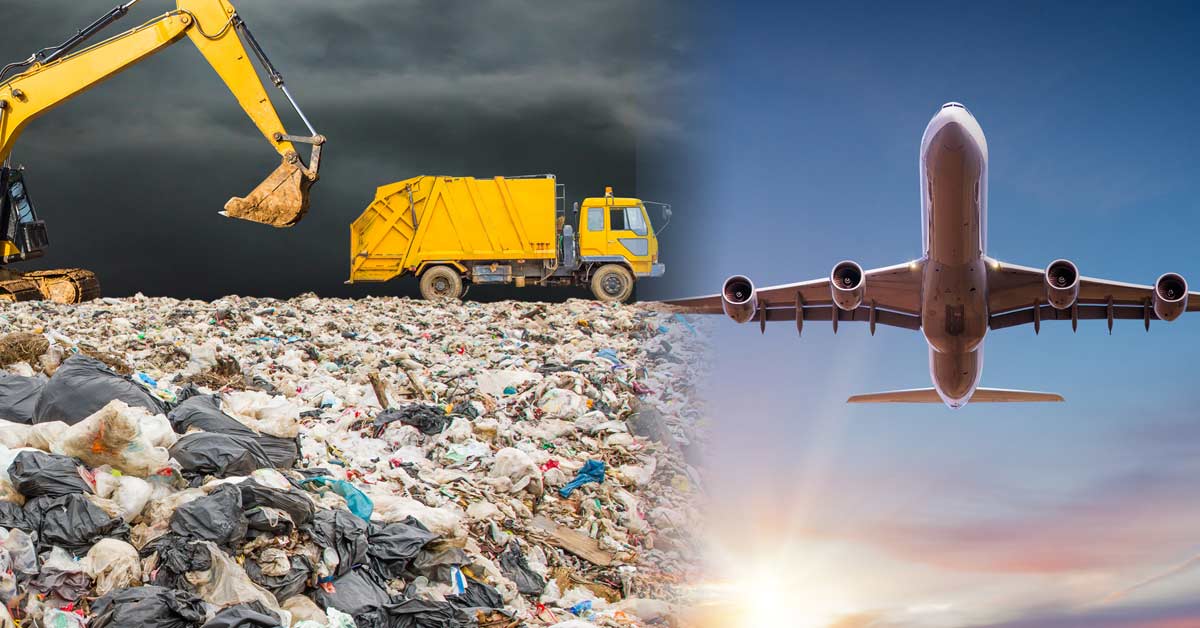
As the world looks deeper to find creative solutions for renewability, the attention seems to continue to return to something we all deal with: our garbage.
Municipal solid waste, or MSW, is nothing new in the sustainability world. We’ve seen all sorts of ways we can convert our trash into usable feedstocks or energy sources to power a sustainable future.
However, the latest innovations are directing those efforts toward the budding world of sustainable aviation fuel.
This focus is already directly on the sights of many operations within the UK. 27.3 million tons of MSW are collected annually in the UK. Accordingly, there lies a substantial untapped resource that can power the ever-growing SAF market.
Turning Household Waste into Fuel for the Skies
Recent studies, particularly from the Manchester Airports Group, have proposed a groundbreaking idea of utilizing household waste for SAF production. The process could potentially result in significant carbon dioxide savings, surpassing the achievements of the current dominant waste-to-energy (WtE) market.
As mandates and blending requirements amp up, it’s no surprise that the demand for biofuel and other renewables continues to surge. There is a growing momentum among potential producers and consumers to prioritize waste as the primary feedstock for SAF production. This shift aligns seamlessly with the increasing integration of renewables in power generation and the subsequent decarbonization of the power grid.
With the green evolution unfolding very quickly, energy from waste (EFW) plants are feeling the heat. Once heralded as low-carbon power sources, EFW facilities are now facing scrutiny for their environmental impact.
How EU Policy Could Improve Energy from Waste Accounting
The changing perception of EFW plants is not limited to the industry level. It is also reverberating in policy discussions within the European Union.
There are active proposals to incorporate EFW plants into the EU Emissions Trading Scheme. The end result would require plants to account for their emissions financially. Such a move could potentially disrupt the economics of EFW operations.
Using Waste for SAF: A Better Solution?
So, what’s the compromise here? As SAF continues searching for feedstocks to power its development, garbage may just fit the bill.
The compelling argument for redirecting MSW toward SAF production is rooted in the data itself. The aviation sector is quickly recognizing the imperative for decarbonization in their operations and logistics. This means that SAF will continue to take center stage in the industry’s future.
But some questions remain. Primarily, how does redirecting waste to SAF production solve the problem?
Presently, the incineration of 8.5 million tons of MSW annually generates usable power. However, the conserved CO2 within this process is, to put it bluntly, hardly making an impact.
In contrast, diverting the same ton of MSW to SAF production could yield a much greater CO2 reduction—five times what incineration could save. This gap is poised to widen further as power grids transition toward greener sources.
By implementing these savings across the aggregate volume managed by EFW, a considerably higher amount of CO2 reduction could be achieved. This analysis suggests that a simple shift in the utilization of MSW could lead to carbon savings that are much better aligned with long term sustainability goals.
High Potential with SAF and MSW
To highlight the CO2 difference, SAF tech firm Velocys has shared some numbers from their Altalto plant project. In developing a commercial waste-to-SAF plant in Immingham, UK, Velocys aims to produce 20 million gallons of SAF annually.
The project will yield a net negative in carbon emissions and conserve approximately 350,000 tons of CO2 emissions each year. For comparison, this is a decrease of 150% in greenhouse gas emissions from traditional jet fuels. Even better, it conserves a much greater number of emissions from waste than typical incineration could yield.
The Slow Transition of Aviation to Renewables
The data is clear: waste-to-SAF works, and it works better than most other means of using MSW for renewable energy.
Nevertheless, it is crucial to acknowledge that this shift only addresses 7.5% of the total aviation liquid fuel demand in the UK. The other 92.5% of UK’s demand relying on fossil fuels underscores the necessity for diverse feedstocks and technologies to increase SAF production.
Despite the advocacy efforts of waste-to-energy plants, the prevailing momentum appears to be shifting away from them. This shift has been noted by the broader market in several different industries. For instance, the maritime blending sector has also taken an interest in converting waste feedstocks for bio-bunkering.
Read More: Bio-Bunkering Gaining Traction as Calls for Decarbonization Grow
The ambitious vision for a cleaner future hinges on reshaping our perception of waste. By reimagining MSW as a valuable resource rather than a mere inconvenience, we can unlock a substantial carbon-saving solution and redefine the narrative of sustainable aviation fuel.
To achieve these lofty aims, it is crucial to prioritize transparency and honesty in conversations surrounding waste as a feedstock for SAF production. Working together, we can drive meaningful change and create a more sustainable future for aviation. Let's not waste this opportunity.
Carbon Mitigator: Insights You Can Trust, Data You Can Count On
Waste-to-SAF is one piece of a much broader picture in terms of renewables and sustainability. As the call to decarbonize grows more urgent, do you have what you need to transition successfully?
The Carbon Mitigator report from ResourceWise provides streamlined data and insights designed to help your business decarbonize. The report provides timely, accurate pricing data on multiple biofuel types, including modeled pricing on multiple SAFs trading on the market today. And our news and insights ensure your business stays up –to date on important breakthroughs, updates, and emerging regulations.
Learn more about the Carbon Mitigator report, only available in Prima CarbonZero from ResourceWise.





